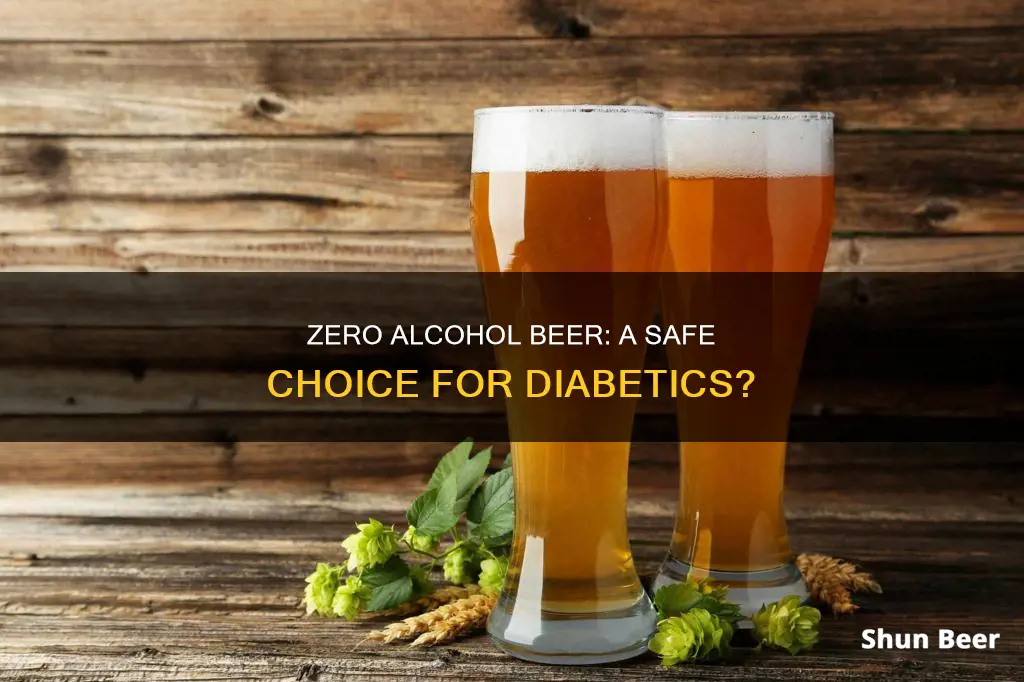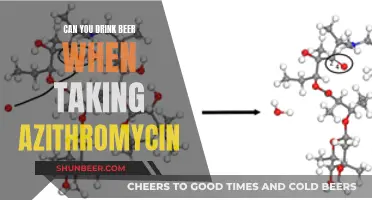
People with diabetes can drink alcohol in moderation, but it's important to be aware of how it can affect your body and how to manage this. Alcohol can interfere with your blood sugar levels and increase the risk of hypoglycemia, especially if you're on insulin or medication that can cause low blood glucose. It's also important to watch your weight as alcoholic drinks can be high in calories. Non-alcoholic beers can be an option for diabetics, but it's crucial to check the sugar and carbohydrate content as some varieties may still impact glucose control.
| Characteristics | Values |
|---|---|
| Can diabetics drink zero alcohol beer? | Yes, but diabetics should be mindful of the sugar and carbohydrate content in non-alcoholic beers. |
| Recommendations for diabetics drinking alcohol | No more than 14 units of alcohol per week, spread over at least three days. Drink alcohol with food. Have several alcohol-free days each week. |
| Alcohol and diabetes | Alcohol can affect blood sugar levels and increase the risk of hypoglycemia. Alcohol can also affect weight control and increase the risk of certain cancers and heart disease. |
| Non-alcoholic beer options for diabetics | Beers with modified carbohydrate composition, such as those enriched with isomaltulose and resistant maltodextrin, can lead to lower glucose peaks. Beers with lower carbohydrate and sugar content, such as IMPOSSIBREW, are also recommended. |
What You'll Learn
- Zero-alcohol beer can be an option for diabetics but it's important to check the sugar and carbohydrate content
- Diabetics should pay attention to serving size, total carbohydrates, added sugars, fibre and fat when reading nutrition labels
- Alcohol can cause hypoglycaemia (low blood glucose) as it stops the release of glucose from the liver
- Diabetics should avoid low-sugar beers as they tend to be higher in alcohol
- Diabetics should also avoid low-alcohol wines as they are often higher in sugar

Zero-alcohol beer can be an option for diabetics but it's important to check the sugar and carbohydrate content
Zero-alcohol beer can be an option for diabetics, but it is important to check the sugar and carbohydrate content. While non-alcoholic beers are often lower in calories, they can be higher in sugar and carbohydrates than alcoholic beers. This is because sugar is often added to improve flavour once the alcohol has been removed. As a result, non-alcoholic beers can impact glucose control and increase the risk of hypoglycaemia.
For example, Heineken 0% has 1100% more sugar than the original alcoholic Heineken, and San Miguel 0% has over 70% more carbohydrates than the original. Non-alcoholic beers can contain anywhere from 3.7g to 9g of carbohydrates per 100ml. In comparison, a standard 330ml can of Coke contains 35g of carbohydrates.
However, there are some non-alcoholic beers with much lower sugar and carbohydrate content. For instance, IMPOSSIBREW contains no sugar and has only 27 calories per 440ml can. Studies have also shown that consuming alcohol-free beers with modified carbohydrate compositions, such as those enriched with isomaltulose and resistant maltodextrin, can lead to lower glucose, insulin, and incretin hormones.
Therefore, it is important for diabetics to carefully read nutrition labels and choose non-alcoholic beers with lower sugar and carbohydrate content. By doing so, they can still enjoy the taste of beer while managing their blood sugar levels effectively.
Beer and Bunnies: A Toxic Mix?
You may want to see also

Diabetics should pay attention to serving size, total carbohydrates, added sugars, fibre and fat when reading nutrition labels
Diabetics can still drink alcohol, but it is important to do so in moderation and with careful attention to nutrition labels. This is because alcohol can interfere with blood sugar levels, weight management, and other health concerns. When reading nutrition labels, diabetics should pay attention to several key components:
Serving Size
The serving size listed on the nutrition label is crucial, as all other nutritional information is based on this amount. If consuming more than one serving, adjust the other values accordingly. For example, a standard serving size for beer is 284ml, but a typical can or bottle is often 330-440ml, which is significantly larger.
Total Carbohydrates
Total carbohydrates include sugar, starch, and fibre. Use the total grams of carbohydrates when counting carbs or planning meals. Aim for foods with a lower % Daily Value of total carbohydrates. Alcoholic drinks often contain carbohydrates, which can affect blood sugar levels.
Added Sugars
Look for the amount of added sugars, which are now required to be listed separately from naturally occurring sugars. Choose foods with minimal or no added sugars to better control blood glucose levels. Many alcoholic drinks, including non-alcoholic beers, are high in added sugars, which can impact glucose control.
Fibre
Opt for foods higher in dietary fibre, as it can help slow the absorption of sugar and improve blood sugar levels. Fibre is an important component of a healthy diet for diabetics, as it aids in digestion and can help regulate blood sugar spikes.
Fat
While monitoring overall fat intake is important for overall health, pay special attention to saturated and trans fats. Aim for foods with a lower % Daily Value of these unhealthy fats. Some alcoholic drinks, such as cocktails or mixed drinks, may contain fats from dairy or other ingredients, so it is important to check the labels.
By carefully examining nutrition labels and considering serving size, total carbohydrates, added sugars, fibre, and fat, diabetics can make informed choices about their alcohol consumption and effectively manage their blood sugar levels. It is also important to follow general guidelines for sensible drinking, such as limiting alcohol intake to no more than 14 units per week and spreading consumption over several days.
Beer and Amnesteem: Is It Safe to Drink Alcohol?
You may want to see also

Alcohol can cause hypoglycaemia (low blood glucose) as it stops the release of glucose from the liver
Alcohol can cause hypoglycaemia (low blood glucose) in diabetics and non-diabetics alike. However, the risk is higher for people with diabetes, especially those taking insulin or medications like sulfonylureas that increase insulin production. Insulin lowers blood sugar levels, and when combined with alcohol, can cause blood sugar levels to drop too low.
The liver plays a crucial role in maintaining healthy blood sugar levels. It helps control blood sugar levels by storing and producing glucose. Signals from hormones like insulin aid the liver in knowing how much glucose the body needs. However, when we consume alcohol, the liver prioritises breaking it down and eliminating it from the body. As a result, the liver may not release enough glucose to maintain healthy blood sugar levels. This is especially true when drinking on an empty stomach, as there are no other sources of glucose for the body to utilise.
Additionally, alcohol can continue to affect the body and the liver for several hours after consumption. This is important to consider if you drink and take insulin or medications in the evening before bed, as you may be at risk of experiencing hypoglycaemia overnight.
To prevent alcohol-induced hypoglycaemia, it is recommended to avoid drinking on an empty stomach, limit alcohol intake, drink slowly or moderately, and monitor blood sugar levels closely while drinking. If you have diabetes, it is crucial to consult your doctor or healthcare professional before consuming alcohol to ensure you are taking the necessary precautions to maintain healthy blood sugar levels.
Jumping, Beer, and Sky Zone: Is it Allowed?
You may want to see also

Diabetics should avoid low-sugar beers as they tend to be higher in alcohol
Diabetics should be cautious when consuming low-sugar beers as they tend to have a higher alcohol content. While non-alcoholic beers are often lower in calories, many mainstream options contain higher sugar and carbohydrate levels than their alcoholic counterparts. For instance, Heineken 0% has 1100% more sugar than the original Heineken, and San Miguel 0% has 70% more carbohydrates.
Alcohol can interfere with diabetes medication and insulin, increasing the risk of hypoglycaemia or "hypos". It inhibits the liver from releasing glycogen to regulate blood sugar levels, which can lead to dangerously low blood sugar. Additionally, the sugar and carbohydrates in alcoholic drinks can cause an initial spike in blood sugar levels, followed by a drop, increasing the risk of hypoglycaemia for up to 24 hours after drinking.
To manage blood sugar levels, diabetics should carefully read nutrition labels and opt for beverages with lower total carbohydrates, minimal added sugars, and higher dietary fibre. Some non-alcoholic beers with modified carbohydrate compositions can lead to lower glucose, insulin, and incretin hormone levels. However, it is crucial to monitor consumption, as the calories and carbohydrates in these drinks can still add up.
When drinking, diabetics should be mindful of their alcohol intake and spread their consumption over several days. It is recommended to have several alcohol-free days each week and not to exceed 14 units of alcohol per week for both men and women. Additionally, drinking on a full stomach, alternating with water, and consuming carbohydrate-rich foods alongside alcoholic beverages can help manage blood sugar levels.
Beer's Carbonation: What Makes it Fizz?
You may want to see also

Diabetics should also avoid low-alcohol wines as they are often higher in sugar
Diabetics should be cautious when consuming low-alcohol wines due to their typically high sugar content. While non-alcoholic drinks may seem like a healthier choice, it is crucial to scrutinise their nutritional information.
Mainstream non-alcoholic beers often contain higher levels of sugar and carbohydrates than their alcoholic versions. This occurs because sugar is frequently added to enhance the flavour after the alcohol removal process. For instance, Heineken 0% contains 1100% more sugar than its original version, while San Miguel 0% has 70% more carbohydrates.
Similarly, low-alcohol wines are often produced using low fermentation methods, resulting in higher residual sugar levels. Some non-alcoholic wines can contain over 60 grams of sugar per litre. The lack of mandatory nutritional labelling on alcoholic beverages in the UK makes it challenging to determine their precise sugar and carbohydrate content.
Diabetics must carefully manage their blood sugar levels and be aware of how different substances can impact them. While non-alcoholic beers can be an option, it is crucial to select them carefully by considering their sugar and carbohydrate content. Some non-alcoholic beers can impact glucose control and contain up to 8-9 grams of carbohydrates per 100ml.
However, studies suggest that consuming alcohol-free beers with modified carbohydrate compositions, such as those enriched with isomaltulose and resistant maltodextrin, can lead to lower glucose, insulin, and incretin hormone peaks. These modified alcohol-free beers also resulted in lower glucose levels when consumed with white bread compared to consuming the same amount of carbohydrates from white bread alone.
When choosing beverages, diabetics should opt for those with minimal or no added sugars to better control their blood glucose levels. It is also essential to pay attention to serving sizes, total carbohydrates, fibre, and sodium content to make informed choices that align with their blood sugar management goals.
Beer After a Colonoscopy: What You Need to Know
You may want to see also
Frequently asked questions
Yes, diabetics can drink zero-alcohol beer, but they should be mindful of the sugar and carbohydrate content, as these can still impact blood glucose control. It is important to read nutrition labels and opt for beverages with lower sugar and carbohydrate content.
When choosing a zero-alcohol beer, look for options with lower sugar and carbohydrate content. For example, some recommended choices include:
- Brewdog Punk AF Alcohol Free IPA: 50 calories, 10g carbs, 6g sugar
- Stella Artois Premium Alcohol Free Lager Beer: 60 calories, 13.9g carbs, 2.6g sugar
- Heineken Alcohol Free Beer: 69 calories, 16g carbs, 4.3g sugar
Diabetics should be cautious when consuming zero-alcohol beer, especially if they are on insulin or medication that can cause hypoglycaemia. It is recommended to monitor blood glucose levels before and after drinking, as alcohol can interfere with blood sugar levels and increase the risk of hypoglycaemia. Additionally, drinking in moderation and avoiding drinking on an empty stomach are important precautions to take.







